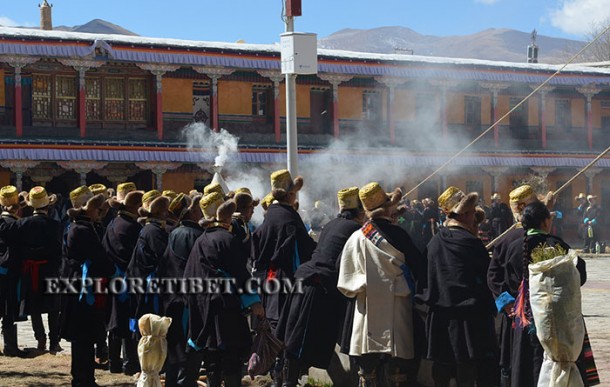
2014 Celebration of Losar—the Grand Tibetan New Year Festival

Without a shadow of doubt, Losar is the most-awaited festival for all the Tibetans—young and old, laymen or monks and nuns alike; just like the joy of Christmas celebration in the west. If you are able to make your Tibet tour during this time, you are sure to witness one of the most spectacular sights of genuine Tibetan culture and life. You won’t believe your luck!
The Tibetan world Losar literally means “New Year”. It is the grandest festival in Tibet that involves all forms of activities ranging from cultural and religious to great merriments. Traditionally, the grand festival goes on for 15 days, starting from the first to the 15th day of the first month of the Tibetan Calendar. The Tibetan New Year for 2014 starts from 2 March of Western Calendar.
The Day One of the Losar is called the Lama Losar. Traditionally, the Tibetan Buddhists begin the New Year by greeting and honoring their respective Gurus, or the Dharma teachers on the Day One of the Losar. Guru and disciple greet each other by wishing peace and prosperity in the New Year. On this day laypeople make short visits to people to offer greetings and best wishes for the New Year. They enjoy Changkol, a traditional hot beverage made from Chang, the Tibetan beer. People also pay visit to the temples and monasteries in their locality on Day One to seek blessing for the New Year.
The Day Two of the Losar is called Gyalpo Losar, meaning “King’s” Losar. Historically this is the day for paying tribute to the kings and leaders of the society. During the ancient times, Tibetan kings used to exchange greetings with ministers and their people. Later on, when Dalai Lamas became the ruler of Tibet, they used to exchange greetings with government officials and foreign dignitaries.
The Day Three of the Losar is called Choekyong Losar. On this day, Tibetan laypeople make special offerings to the various deities and dharma protectors. There are activities like raising prayer flags from hills, mountains and rooftops and burn juniper leaves and incense as offerings besides saying prayers.
The formal spiritual observance of Losar lasts for the first three days, however, festivities continue until Chonga Choepa, the Butter Lamp Festival held on the 15th day of the Losar. On this final day of the celebration, there will be monks performing purification rituals before crafting massive yak butter sculptures that are to be displayed in monasteries, which is like a grand religious art exhibition.
Losar is a grand festival of both spiritual and merrymaking, for the laypeople they have exotic enjoyment from 4th to the 14th day of the Losar where they will be hosting or visiting parties with relatives and friends. Traditionally, Chang—the Tibetan beer used to be a popular drink on this occasion, but the emergence of beer and other liquors have gradually eclipsed it.
Nowadays Losar has almost become a worldwide festival with considerable size of Tibetan communities all over the world, mostly in India and Nepal as well as in Americas and Europe. And the Losar celebration also takes place in many of non-Tibetan communities where there is influence of Tibetan Buddhism, like Bhutan and several Northeastern states of India.
According to some history texts, the Losar celebration predates Buddhism in Tibet and can be traced back to as early as early Bon period. During this period of Bon tradition, a spiritual ceremony was held every winter, in which people made various offerings like incense to appease the deities and local spirits. It is believed that this religious festival gradually evolved into an annual Buddhist festival with a suitable linkage with Tibetan Calendar.
In spite of the little materialistic progress, Tibetans are historically well-known over the world as one of the happiest peoples. And Tibetans crack joke saying that they hold the record on earth for having the longest New Year celebration with 15 consecutive days, with some people going to the extent of 30 days! So it is really a scene to appreciate if you can travel Tibet during this time.
Written by Tashi Namgyal
Explore Tibet Post Writter
Recent Posts
Trekking in Tibet
The Best Way to Experience Mount Kailash in Tibet
The Perfect Tibet Tour Package
All Categories
- About Tibet
- book a Tibet tour
- Buddhism Practice
- Budget Tour
- China-Tibet Train
- Customized Tibet tour
- Historical Sites
- Hot Springs in Tibet
- News
- Photography in Tibet
- Tibet attraction
- Tibet Group Visa
- Tibet Motorcycle Tour
- Tibet Small Group Tours
- Tibet Tours and Tibetan Tour Guide
- Tibet Train
- Tibet Travel FAQs
- Tibet Travel Information
- Tibet Travel News
- Tibet Travel Permit Update
- Tibet Travel Prices Rises
- Tibet Trek
- Tibet Trekking Tour
- Tibet weather and climate
- Tibet Wildlife animals
- Tibet Winter Tour
- Tibetan Buddhism
- Tibetan Cultural Features
- Tibetan Culture and Poeple
- Tibetan Festivals
- What to see in Tibet



